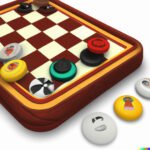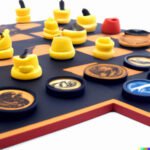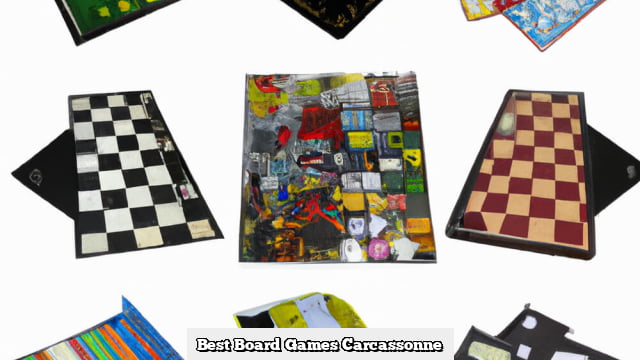Carcassonne is a popular board game that involves strategic tile placement and feature claiming. In this article, we will explore the essential strategies and tips for crafting a winning carcassonne board game strategy, from understanding the basic rules to mastering advanced techniques. Whether you are new to the game or looking to improve your skills, this comprehensive guide will help you elevate your gameplay and outsmart your opponents.
The objective of Carcassonne is to build cities, roads, and fields by placing tiles strategically on the game board. Players use meeples (or followers) to claim these features and earn points. Understanding the intricacies of tile placement, feature claiming, and maximizing points with farmers are crucial elements in developing a successful strategy. By learning how to effectively utilize these gameplay mechanics, players can increase their chances of emerging victorious in Carcassonne.
Moreover, mastering advanced strategies for expanding and blocking opponents can significantly impact the outcome of the game. Knowing when to strategically deploy meeples and followers to control key features such as cities and roads can give players a competitive edge.
With careful consideration and thoughtful planning, players can enhance their overall gameplay experience and increase their likelihood of achieving victory in Carcassonne. So let’s dive into this captivating world of strategic thinking and tactical maneuvering within the realm of Carcassonne.
Overview of the Game Rules and Objective
Carcassonne is a tile-placement game that has gained popularity for its strategic and competitive gameplay. The game is designed for 2-5 players and the objective is to score the most points by strategically placing tiles and claiming key features on the board. Understanding the game rules and objectives is crucial to developing a successful Carcassonne board game strategy.
Game Rules
The game begins with a single starting tile placed in the center of the playing area. Players take turns drawing a tile at random and placing it adjacent to existing tiles, connecting roads, cities, fields, and monasteries. Players can also choose to place a meeple on the tile they have just played, claiming ownership of specific features on that tile.
Objective
The primary objective of Carcassonne is to score points by completing features such as cities, roads, and monasteries. When a feature is completed, players receive points based on the size of that feature. Additionally, farmers placed in fields can earn points at the end of the game based on the number of completed cities adjacent to their fields.
Understanding these fundamental game rules and objectives lays the foundation for formulating an effective Carcassonne board game strategy. In order to maximize points and outmaneuver opponents, players must carefully consider their tile placement and meeple placement decisions throughout the game. This understanding will be essential as we delve into specific strategies for success in Carcassonne.
Understanding the Tile Placement Strategy
In Carcassonne, tile placement is a crucial aspect of the game that can greatly impact your overall strategy and chances of winning. The following are some key points to consider when determining your tile placement strategy:
- Connectivity: When placing tiles, it’s important to prioritize connecting roads, cities, and fields in order to maximize points and control key features on the board.
- Strategic Blocking: Look for opportunities to strategically block your opponents from completing their own features, such as cities or roads, by placing tiles in strategic locations.
- Avoiding Traps: Be mindful of potential traps that may limit your options for placing future tiles. It’s essential to plan ahead and think about the long-term consequences of each tile placement.
By understanding these key principles of tile placement strategy, you can gain a competitive edge and make more informed decisions during the game.
Overall, mastering the tile placement strategy in Carcassonne is essential for developing a winning approach. With careful consideration of connectivity, strategic blocking, and avoiding traps, players can enhance their gameplay and improve their chances of achieving victory. Keeping these principles in mind while playing will undoubtedly elevate your overall performance and enjoyment of the game.
Importance of Claiming Key Features Like Cities and Roads
Claiming key features like cities and roads is crucial to mastering the Carcassonne board game strategy. These features offer opportunities for players to earn points and control the game board. Here are some important tips for effectively claiming cities and roads in Carcassonne:
- Be strategic with tile placement: When placing tiles, consider how they will contribute to completing cities and roads. Look for opportunities to connect your own features while blocking your opponents from completing theirs.
- Focus on completed structures: In Carcassonne, completed cities and roads are worth more points than incomplete ones. Prioritize claiming and completing these features to maximize your point potential.
- Use meeples wisely: Placing meeples as knights in cities or as thieves on roads can help you claim ownership of these key features. However, be mindful of when to deploy your meeples, as you have a limited supply.
By understanding the importance of claiming key features like cities and roads, players can develop a winning strategy in Carcassonne. This aspect of the game requires careful planning, strategic tile placement, and thoughtful use of meeples to outmaneuver opponents and secure victory.
Overall, mastering the strategy of claiming key features like cities and roads is essential for success in Carcassonne. With a solid grasp of this aspect of the game, players can elevate their gameplay and increase their chances of emerging victorious in this classic board game.
Maximizing Points With Farmers and Fields
In the Carcassonne board game, one of the key strategies to maximize points is to effectively use farmers and fields. Farmers are unique meeples that are not placed on the board like other followers, but rather are placed on fields. These farmers can earn a player significant points at the end of the game if used strategically.
The key to maximizing points with farmers and fields is to strategically place them in areas that can be connected to as many completed cities as possible. As cities are completed, players should look for opportunities to expand their fields to cover more completed cities.
It is also important to keep an eye on which players are competing for control of certain fields, as multiple players can place farmers in the same field, potentially splitting the points earned from that area.
Another effective strategy for maximizing points with farmers and fields is to focus on connecting incomplete cities and roads with large expanses of fields. This allows players to claim more territory with their farmers and potentially earn more points at the end of the game. This approach requires careful planning and tile placement throughout the game in order to create a strategic network of fields.
Overall, understanding how to strategically use farmers and fields in Carcassonne is essential for crafting a winning strategy. By paying close attention to connecting completed cities, expanding fields, and competing for control over key areas, players can significantly boost their point totals at the end of the game. Mastering this aspect of Carcassonne strategy can lead to success in this popular board game.
Effective Use of Meeples and Followers
Understanding Meeples and Followers
In Carcassonne, meeples are the small wooden figures that players use to claim territories on the game board. Understanding how to effectively use these meeples and followers can greatly impact your strategy and overall success in the game. Meeples can be placed on different features such as cities, roads, monasteries, and fields, each providing different opportunities for scoring points.
Strategic Placement of Meeples
One key strategy for using meeples effectively is to carefully consider where to place them on the board. Cities and roads have the potential to earn higher points when completed, making them desirable locations for meeples. However, it’s important to balance this with managing your meeples efficiently so that you don’t run out too quickly.
Players should also be mindful of placing meeples on incomplete features that may take several turns to finish. This can tie up a meeple for an extended period but provides a potential for a big pay off at the end of the game.
Risk Management With Meeples
Another important aspect of using meeples effectively is risk management. It’s important to weigh the potential rewards against the risk of losing a meeple if a feature goes unfinished. Additionally, being strategic about when and where to place your meeples can also involve blocking opponents from completing their own features or strategically navigating around opponents’ placement.
Advanced Strategies for Expanding and Blocking Opponents
In Carcassonne, a key to success is not only expanding your own territory but also being able to block your opponents from doing the same. This can be achieved through careful tile placement and strategic use of meeples. One effective strategy is to place tiles in a way that will make it difficult for opponents to complete their cities or roads, thereby limiting their point opportunities.
Another advanced strategy for expanding and blocking opponents in Carcassonne is to pay close attention to what your opponents are doing and try to disrupt their plans. For example, if you see an opponent working on a large city or road, you can strategically place tiles to prevent them from completing it, or even place your own followers on their incomplete structures to take control of them.
It’s also important to keep an eye on the available tiles and plan ahead for potential moves by both yourself and your opponents. Being able to predict what tiles might come up next can give you a strategic advantage in both expanding your own territory and blocking your opponents’ plans.
| Strategy | Details |
|---|---|
| Tile Placement | Strategically place tiles to hinder opponents’ progress |
| Disrupting Opponents’ Plans | Pay attention to opponents’ moves and disrupt their city or road completion |
| Anticipating Next Moves | Predict available tiles and plan ahead for optimal positioning |
Tips for Crafting a Winning Carcassonne Board Game Strategy
Crafting a winning Carcassonne board game strategy requires careful planning and consideration of various elements within the game. One important aspect to consider is the tile placement strategy.
Players must be thoughtful about where they place their tiles in order to maximize their points and claim key features on the board. As the game progresses, it becomes crucial to understand how to strategically claim cities and roads, as well as how to effectively use farmers and fields to earn additional points.
In addition to tile placement, utilizing meeples and followers effectively can greatly impact a player’s success in the game. Meeples should be placed strategically in order to claim key features such as cities, roads, and monasteries. Understanding when and where to place meeples is essential for maximizing points and preventing opponents from claiming valuable features.
For more advanced players, it is important to focus on expanding one’s own features while also blocking opponents from completing their own. This can involve strategically placing tiles in a way that limits an opponent’s ability to complete large features or secure valuable points. Additionally, it is important to carefully consider when and where to deploy meeples in order to block opponents’ progress.
Ultimately, crafting a winning Carcassonne board game strategy involves a combination of careful tile placement, effective meeple usage, and strategic expansion and blocking techniques. By carefully considering these elements, players can increase their chances of success in this highly competitive game.
| Aspect | Strategy |
|---|---|
| Tile Placement | Thoughtful positioning for maximizing points |
| Meeples | Strategic placement for claiming key features |
| Expansion & Blocking | Careful use of tiles and meeples for both personal expansion and opponent blocking |
Conclusion and Final Thoughts on Mastering Carcassonne Board Game Strategy
Mastering the Carcassonne board game strategy requires a deep understanding of the game rules, tile placement, and feature claiming. As players advance in their knowledge of the game, they can also explore advanced strategies for expanding and blocking opponents. By effectively using meeples and followers, players can maximize their points and work towards crafting a winning strategy.
One key aspect of mastering Carcassonne board game strategy is to understand the importance of claiming key features like cities and roads. These features not only provide immediate points but also play a crucial role in shaping the landscape for future tile placements. Additionally, maximizing points with farmers and fields adds another layer of complexity to the game that strategic players can explore.
In conclusion, as players continue to delve into the intricacies of Carcassonne board game strategy, they will find that it offers a rich and immersive gaming experience. By employing effective tile placement, strategically claiming key features, and maximizing point opportunities with meeples and followers, players can develop a competitive edge.
It is through practice and experimentation that players can truly master the art of Carcassonne board game strategy. Whether playing casually with friends or competing in tournaments, honing one’s skills in Carcassonne will lead to an enriching gaming experience.
Frequently Asked Questions
How Do I Win Carcassonne?
Winning Carcassonne requires a combination of strategic tile placement, clever meeple deployment, and flexible long-term planning. It’s important to optimize your moves and adapt to your opponents’ strategies in order to claim victory.
Is Carcassonne a Skill or Luck?
Carcassonne is considered more of a skill-based game rather than relying solely on luck. While drawing tiles may involve an element of chance, the ability to make strategic decisions based on the tiles drawn and the opponents’ actions is crucial for success.
Is Carcassonne Easier Than Catan?
Whether Carcassonne is easier than Catan depends on individual preferences and play styles. Some players may find Carcassonne’s simpler rules and focus on tile placement more straightforward, while others may prefer Catan’s resource management dynamics. It ultimately comes down to personal preference and gaming experience.

I love playing all kinds of games – from classics like Monopoly to modern favourites like Ticket to Ride.
I created this blog as a way to share my love of board games with others, and provide information on the latest releases and news in the industry.





